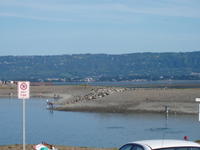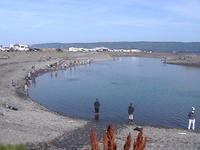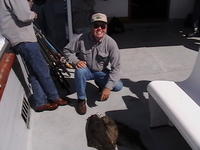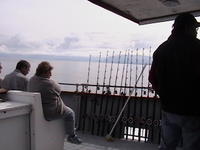
This session is for my fishing friends.
Homer is known as the Halibut Fishing Capital of the World. It also offers salmon fishing by charter boat or in local streams. I will cover the very different salmon fishing that I observed and tried at the Homer Spit “Fishing Hole”.
This “Fishing Hole” is a special situation unique to Homer Spit as far as we know. The town has created a large rock lined artificial lake on the Spit that I “guesstimate” to be about 100 yards wide and roughly 300 yards long with a channel to the sound. This is really a separate tidal pool where the very large tides in the area can flow through the channel into the pool and refresh and raise the level of the water in the hole twice a day by up to 16 feet or so. The pool is considerably deeper than the channel. As the tide lowers the water flows out until at low tide the pool is basically cut off from the source until the tide once again rises sufficiently to fill the pool all over again. Into this free and public Fishing Hole” they plant young red and silver salmon each spring so that they “imprint” themselves with the location. When they are large enough they go out of the hole to the sea to spend two to three years at sea growing and maturing. Since they were “imprinted” with the Fishing Hole as the location from which they went to sea it to this same Fishing Hole that they return to spawn after their time at sea. This is the same process that occurs naturally in nearly all the rivers and streams in the area. However once the salmon return to the Fishing Hole, they remain in the hole looking for a place to spawn and it makes a great place for local folks and visitors to go salmon fishing! Note: The fish don’t actually spawn in the hole and unless caught will end up dying in the hole so the authorities open the hole up to allow snagging of salmon at a certain point toward the end of the season. Until that snagging is allowed, the fishing is sort of like that method of mouth snagging I have described in the section from Hope Alaska: except, that there is no current, so fishermen of all ages tend to use bobbers tied at the end of the line, a 4/0 or 5/0 bare hook, or a hook with nothing but a small piece of bright colored yarn on the hook so the hook is easier to see. The hook is tied about three feet back from the end at the bobber. The hook is tied so that the opening of the hook faces toward the reel and a small split shot weight is added just outside the hook toward the bobber. This rig allows the line to sink at the hook and be suspended below the surface by the bobber in hopes that the salmon will swim into the line, drag it in their mouth and allow the fisherman to pull the line sharply and set the hook into the outside of the mouth. This is all very strange indeed to a Pennsylvania fly fisherman who loves dry flies!!!



Both Pat and I were fascinated by the Fishing Hole. Over the several days we spent in and around Homer, we spent numerous times watching salmon almost continually jumping, often fully clear of the water or at times seemingly “tail walking” on the surface while an endless number of men, women and children ring the Fishing Hole trying their luck. Any time day or night, high tide or low tide there is a substantial number of folks fishing the hole. We could see this action right from our RV window and took photos and videos of the action and fish jumping.
The first night on the spit we went to watch and I carefully observed one gentleman who was using a fly rod and had two fish of his six fish limit of silver salmon already on the bank by him. I watched as he caught two more in quick succession while most others were futilely casting and retrieving their bobber rigs. When I spoke to him he readily confided to me his secret of his success. He was using a bare 4/0 hook to the 10-foot leader at the end of his floating fly line but affixed a small piece of Styrofoam about the size of a common eraser on a pencil to the hook so that it sunk slowly. He flipped a small coil in the floating fly line after each cast to serve as a form of strike indicator, should any fish touch the line. He then resumed fishing and promptly caught two more to fill out his limit. Others were certainly catching fish and probably every fourth or fifth fisherman had a fish or two but only a few had a system that yielded their limit in a short time.
Naturally I tried my luck but without a proper weight fly rod I used the bobber and weight system. I was UNSUCCESSFUL but it was certainly entertaining to watch the whole scene and watch the fish swim either over or under my line and often jumping nearby. These were 5 to 7 pound Silver or Coho salmon and when hooked they put up quite a fight. The steep sharp rock banks made landing them tricky and many a fish was lost just as it was being slid up the bank. Most successful folks used the rocks to dispatch the flopping fish, although a few carried a small Billy Club for that purpose. Only a very few used landing nets.
Now about Halibut Fishing. There are probably a dozen or more businesses that have shops on the spit to offer charter halibut fishing. The limit is two halibut a day and the most common charter is an all day charter that goes fairly far out to deeper water to try for larger fish. They can go up to several hundred pounds and there is a big contest going on for the largest halibut each year and each boat owner of course wants to be the skipper of the winner to drum up more business. There are also a few who offer half day charters that go closer into shallower water and there are also a few overnight boats that allow you to catch and keep two days limits by doing so over the night into the next day. These later charters have sleeping accommodations on board. The cost for the all day trips is around $165 while the half-day is about $90 and the overnight about $185. What you choose sort of depends on the time you have available and how much halibut you want. Watching the resulting catches from some of those being brought in, and not having the freezer space in the RV and not wanting to ship home, for a substantive expense, a lot of frozen halibut I chose to do the half day charter. They almost always have everyone catch their limits and the fish average about 20 to 30 lbs. with a total net fillet weight of about 15 lbs from the two fish.
 I went on an afternoon run and the seas were
I went on an afternoon run and the seas were 
 nearly glassy calm. We all caught our limit, and many of us, myself included hooked and landed 4 or 5 fish, seeking a larger one and choosing which ones to keep while the others were thrown back. The spot our captain took the 16 of us to was immediately productive. Bait was large cut up herring and the a rods were short and stiff and used a two pound weight to get it down to the bottom in the rather strong tidal currents.
nearly glassy calm. We all caught our limit, and many of us, myself included hooked and landed 4 or 5 fish, seeking a larger one and choosing which ones to keep while the others were thrown back. The spot our captain took the 16 of us to was immediately productive. Bait was large cut up herring and the a rods were short and stiff and used a two pound weight to get it down to the bottom in the rather strong tidal currents.I will tell you that reeling in a 20 to 30 lb halibut from the bottom was a challenge for the uninitiated or those with weak arms and wrists! There were several young female fisherpeople in the group and some of them really struggled with it. While I was out Pat found a nice Halibut recipe book. While I had 14 pound of my catch frozen in one pound packages, I took home a pound of fresh fillets and Pat fixed them up in an egg and flour dip with Lawry’s Seasoning Salt. They were absolutely delicious! In fact the recipe is called Homer Chicken Fry because if you pull the left over halibut out of the refrigerator the next morning it very closely resembles moist tender chicken and it does! Pat says the secret is not to over cook it! We now both love halibut and I probably should have gone for more!
As an aside, watching the crew fillet the halibut was like watching a master craftsman. Both the young female and the young male deckhand made very short work of each fish with only about 8 or 10 strokes with their knives. They also artfully cut out the “cheek” pieces that are separate from the fillets. I even filmed their work. They kept track of whose fish was whose by issuing each person two large safety pins with unique matching numbers stamped into them and when you chose to keep a fish you gave the crew member one of your pins and it was put through the mouth of the fish. Your two fish were then paired up on the way in to port, filleted and bagged by your number. A smooth operation indeed! You arrived with your fish ready to go and if you wanted they would vacuum seal and freeze it for you for 90 cents a pound and you could pick it up the next day or they will also ship it for you but that can get quite pricey.

1 comment:
Hello. Found your site by searching for brown trout. So many sites have little new info on brown trout.
brown trout
Post a Comment